Have you ever felt the comforting warmth of a bowl of soup wrap around you on a chilly evening, as if it were a hug in a bowl? I’ve found that nothing quite does the trick like my Vegan Thai Coconut Noodle Soup Recipe. This dish holds a special place in my heart, not just because of its rich and exhilarating flavors, but because it’s an easy vegan recipe that brings me immense joy every time I prepare it.
There’s something deeply fulfilling about the process – from selecting the fresh vegetables to stirring the fragrant red curry paste that fills my kitchen with enticing aromas. As you embark on creating this healthy vegan soup, you’ll find moments of peace and satisfaction in the simplicity and wholesomeness of each step. Moreover, knowing that this meal is not only delicious but also nourishing adds an extra layer of comfort to every spoonful.
The best part? This delightful dish can be prepared in just 25 minutes, making it an ideal choice for busy weeknights. You only need a few key ingredients, such as 10 oz of rice noodles and a rich 14 oz of coconut milk. With a bit of love and care in the kitchen, you can transform these simple components into a decadent bowl of goodness that’s sure to be a hit. To better your culinary adventures, consider checking out this vegan spaghetti recipe with tomato basil – another gem for those keen on plant-based delights.
So, gather around your favorite utensils and ingredients, and let’s dive into creating a meal that not only nourishes your body but also warms your soul.
Introduction to Vegan Thai Coconut Noodle Soup
I am thrilled to introduce you to the vibrant world of Vegan Thai Coconut Noodle Soup. This dish stands out with its harmonious blend of spicy, sweet, and creamy notes, making it a favorite for many.
What Makes This Soup Special?
The beauty of this plant-based coconut noodle soup lies in its perfect balance of flavors and textures. The rich coconut milk forms a creamy base enriched with red curry paste, fresh ginger, and garlic. The recipe boasts essential ingredients like:
- 3 tablespoons red curry paste
- 4 cups low sodium vegetable broth
- 1 14-ounce can coconut milk
- 4 ounces brown rice Pad Thai noodles
- 2 big handfuls roughly chopped spinach
- 1 tablespoon minced ginger
Adding protein-packed chickpeas and vibrant spinach elevates the nutritional profile of this homemade Thai noodle soup. Each serving provides 140 calories, 28g of carbohydrates, and 4g of protein, with a modest 1g of fat, making it both wholesome and satisfying.
The History Behind Thai Coconut Soup
The origins of Thai coconut soup, known as “Tom Kha”, date back to traditional Thai cuisine. Originally crafted with chicken or shrimp, the vegan adaptation has embraced plant-forward ingredients. This evolution caters to modern palates while retaining the essence of Thai culinary heritage. The integration of coconut milk, which is rich in Medium-Chain Triglycerides (MCTs), not only imparts creaminess but also boosts energy levels.
This classic dish can be stored in the refrigerator for up to 4 days or frozen for up to 2 months, making it a convenient option for meal prepping. The flexibility and adaptability of this soup make it an excellent choice for various dietary preferences, with gluten-free rice noodles and tamari as easy substitutions for those with allergies.
Essential Ingredients for the Soup
Creating a delicious and authentic Vegan Thai Coconut Noodle Soup starts with selecting the right ingredients. This dish, which takes just 35 minutes to prepare, brings together a harmonious blend of flavors and textures. From the creamy, rich coconut milk to the vibrant red curry paste, each component plays a crucial role in achieving the perfect bowl of gluten-free Thai noodle soup.
Overview of Main Ingredients
The primary ingredients for our vegan soup with coconut milk include canned full-fat coconut milk, which provides a rich and creamy consistency to the broth. Red curry paste adds a vibrant color and depth of flavor, while rice noodles, commonly pad Thai noodles, deliver that essential chewy texture. The vegetable medley typically includes onions, garlic, ginger, cauliflower, and bell peppers, which are cooked to aromatic perfection.
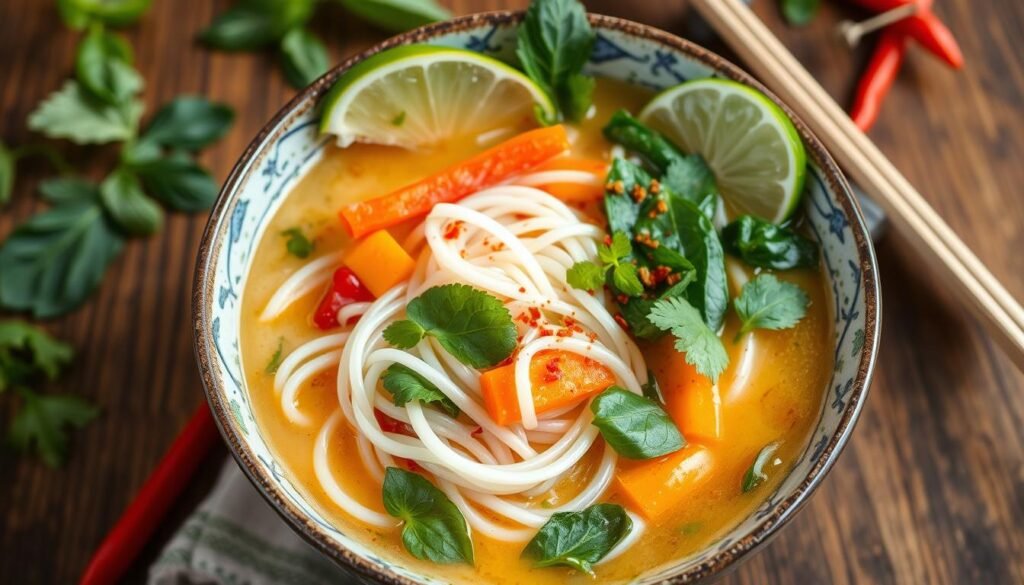
- Canned full-fat coconut milk
- Red curry paste
- Rice noodles (pad Thai noodles or substitutes)
- Onions, garlic, and freshly grated ginger
- Cauliflower and bell peppers
- Soy sauce and coconut sugar for balanced flavors
Each of these ingredients contributes to the overall balance of sweet, salty, spicy, and sour tastes, typical of Thai cuisine. You can learn more by checking out this comprehensive guide by Jessica in the Kitchen.
Alternatives for Common Ingredients
Flexibility is key when it comes to making this vegan soup with coconut milk. If you’re looking for alternatives, zucchini can replace cauliflower for a different texture, or nutritional yeast can be added for an extra savory note. These substitutions allow for a personalized touch without sacrificing the dish’s integrity.
- Alternative to rice noodles: zucchini noodles or soba noodles
- Alternative to red curry paste: yellow curry paste
- Alternative to soy sauce: tamari or liquid aminos for a gluten-free option
- Alternative to coconut sugar: brown sugar or maple syrup
Experimenting with different ingredients ensures that this delicious gluten-free Thai noodle soup can meet various dietary preferences and tastes. Each variation still maintains the soul of the original recipe while allowing for creative customization. This flexibility makes it an inviting option for everyone around the dining table.
Preparing the Vegetables
Preparing the vegetables is a crucial step in making a flavorful vegan soup. The right mix of veggies not only boosts the nutritional value but also enhances the taste. Whether you prefer the crunch of fresh carrots, the earthy flavor of broccoli, or the sweetness of bell peppers, selecting fresh ingredients will make a significant difference. Let’s dive into the specifics of choosing and chopping your veggies for this easy vegan recipe.
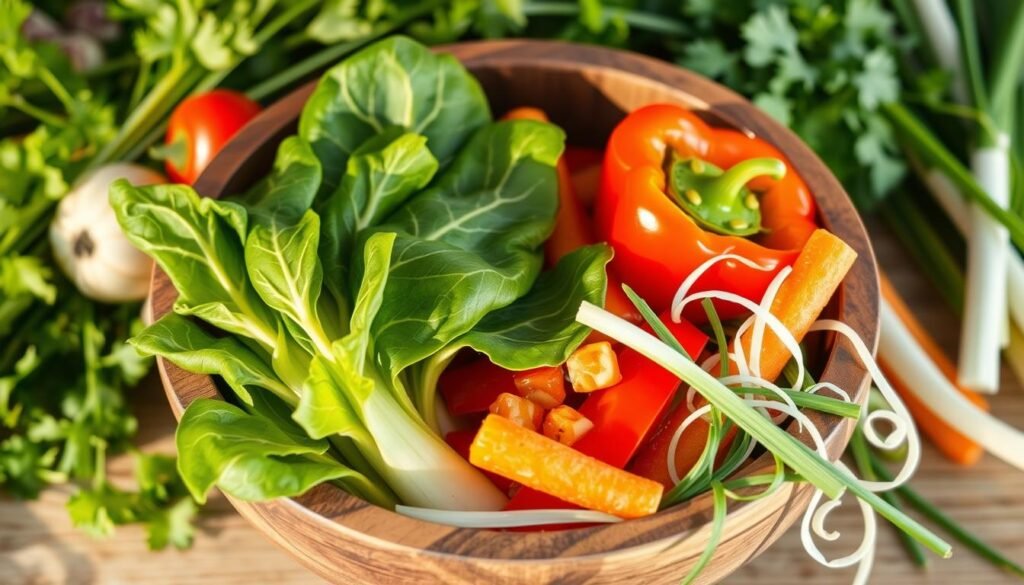
Choosing Your Favorite Veggies
One of the joys of this easy vegan recipe is customizing it with your favorite vegetables. Some great options include:
- Cauliflower
- Zucchini
- Sweet bell peppers
- Carrots
- Cabbage
- Broccoli
For inspiration and to see how other delicious ingredients can be incorporated, check out the Vegan Thai Coconut Noodle Soup recipe. The beauty of this soup is its adaptability, allowing you to select vegetables based on freshness and personal preference.
Tips for Perfectly Chopped Ingredients
Uniform chopping is essential for a well-cooked, flavorful vegan soup. Here are some tips to ensure your veggies are cut just right:
- Use a sharp knife to make clean, precise cuts.
- Chop vegetables into similar sizes to ensure even cooking.
- Slice denser veggies like carrots and potatoes thinner than softer veggies like zucchini and bell peppers.
- Consider dicing tofu into small cubes to help it absorb flavors more effectively.
These tips make the preparation of vegetables an easy vegan recipe, ensuring that your dish is uniformly cooked and full of flavor. Remember, the secret to a great soup lies in the details, so taking the time to prepare your ingredients correctly will pay off significantly.
Flavorful Broth Creation
To craft the perfect broth for your authentic Thai soup recipe, start by focusing on a robust veggie base. By selecting the right ingredients, you can ensure your homemade Thai noodle soup has depth and an irresistible aroma. Let’s dive into the essentials of selecting the best vegetable base and enhancing it with aromatics.
Selecting Your Veggie Base
Choosing the right vegetable broth is vital for an authentic Thai soup recipe. The goal is to use a fresh and flavorful base. Ingredients like bok choy, kale, red pepper slices, and mushrooms simmer well, adding richness to the broth. Creating a veggie base from scratch ensures the purest and most robust flavors, bringing the essence of Thai cuisine to your homemade Thai noodle soup.
Aromatics That Enhance Flavor
Infusing your broth with aromatics is the key to elevating your homemade Thai noodle soup. Commonly used ingredients include onions, garlic, and ginger. Begin by sautéing shallots with garlic and ginger until they become fragrant. Adding Thai red curry paste to the mix introduces a beautiful depth of flavor. Simmer this mixture for 8-10 minutes before combining it with your veggie base. Full-fat coconut milk is then introduced for a creamy consistency, binding all flavors together seamlessly.
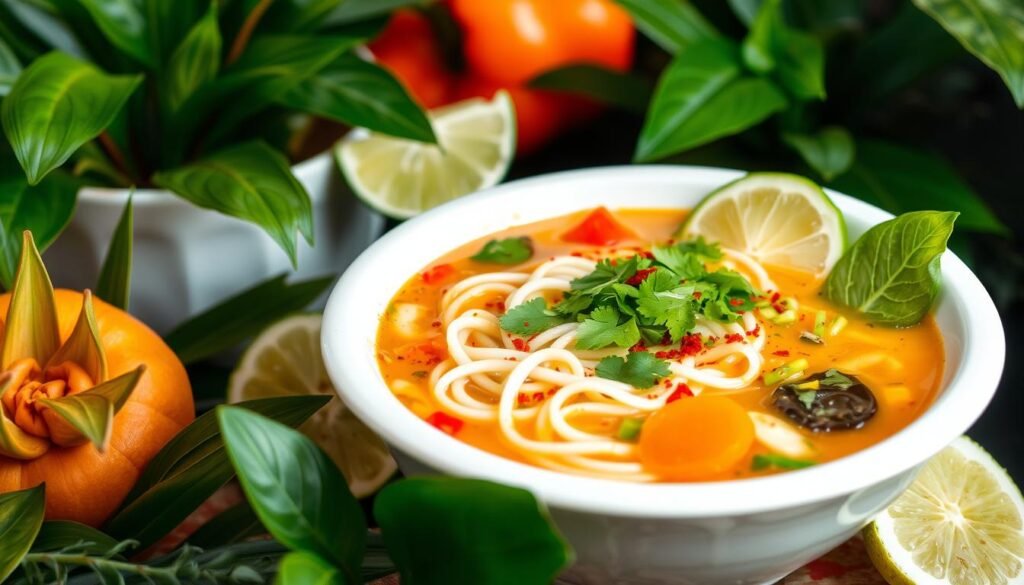
Remember, the secret to an extraordinary broth lies in the balance of ingredients. Play around with the proportions until you find the perfect harmony for your authentic Thai soup recipe.
Making the Coconut Milk Base
Creating a rich and luxurious coconut milk base is key to achieving the ultimate creamy vegan soup. This step ensures your vegan soup with coconut milk stands out with its harmonious blend of flavors and textures.
Choosing the Right Coconut Milk
The first step in making the perfect coconut milk base is selecting the right coconut milk. For a rich and creamy vegan soup, I always opt for full-fat coconut milk. It provides a thick, velvety texture that enhances the soup’s body and flavor. The fat content in full-fat coconut milk helps in achieving that desired creamy consistency, making it the ideal choice for vegan soup with coconut milk. Brands like Thai Kitchen and Aroy-D are excellent options that deliver consistent results.
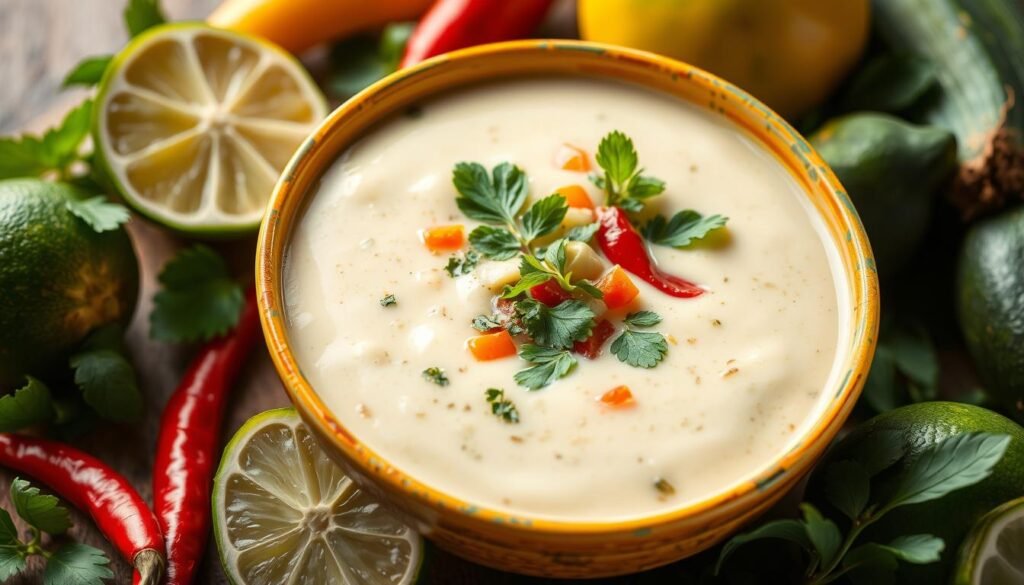
How to Achieve Creamy Consistency
Achieving a creamy consistency in your vegan soup with coconut milk involves a gentle cooking process. Here’s how:
- Gently heat the coconut milk: Start by pouring the full-fat coconut milk into a saucepan over medium-low heat. Stir continuously to prevent curdling and ensure smoothness.
- Combine with broth: Once warm, gradually introduce the coconut milk into your prepared broth mixture. The smooth integration will create a cohesive and creamy texture.
- Final adjustments: Adjust the seasoning as necessary while maintaining a gentle simmer. Stir occasionally to avoid separation and achieve that perfect creamy vegan soup consistency.
By carefully selecting and preparing the coconut milk, you’ll enhance the overall texture and flavor of your dish, making your vegan soup with coconut milk a delightful culinary experience.
Cooking the Noodles
Cooking the noodles for your gluten-free Thai noodle soup can be straightforward yet impactful on the final texture and flavor of your dish. Whether you choose rice noodles or gluten-free ramen, getting the cooking process right is key to creating the perfect easy vegan recipe.
Best Noodle Types for This Recipe
When selecting noodles for this dish, rice noodles and gluten-free ramen are the top contenders. Rice noodles are light and absorb the flavors of the broth beautifully, while gluten-free ramen adds a chewy texture that’s equally delightful. Both options cater to those with gluten sensitivities, ensuring your easy vegan recipe remains inclusive and delicious.
Cooking Tips to Avoid Soggy Noodles
To avoid soggy noodles, cook them just until al dente. Here are a few tips to help you achieve the best results:
- Timing: Follow package instructions carefully and start checking for doneness a minute or two before the recommended time.
- Rinsing: Once cooked, rinse the noodles under cold water to stop the cooking process. This step ensures they maintain their texture when added to the hot broth.
- Separating: Store any leftover noodles and broth separately to prevent the noodles from soaking up too much liquid and becoming mushy.
By following these tips, your gluten-free Thai noodle soup will have perfectly tender noodles that complement the rich and flavorful broth, making for an easy vegan recipe that’s sure to impress.
Adding Protein to Your Soup
Enhancing the protein content of your Vegan Thai Coconut Noodle Soup can turn it into a high-protein vegan soup that is both flavorful and nutritious. Let’s explore some plant-based protein options and how to prepare tofu for maximum flavor.
Plant-Based Protein Options
To make your soup a high-protein vegan soup, you can incorporate tofu, chickpeas, or even lentils. These protein-rich ingredients not only add substance to your soup but also offer various textures and flavors. Extra firm tofu is highly recommended due to its ability to absorb flavors well and maintain its structure during cooking. Chickpeas are another excellent choice, providing a hearty, slightly nutty taste.
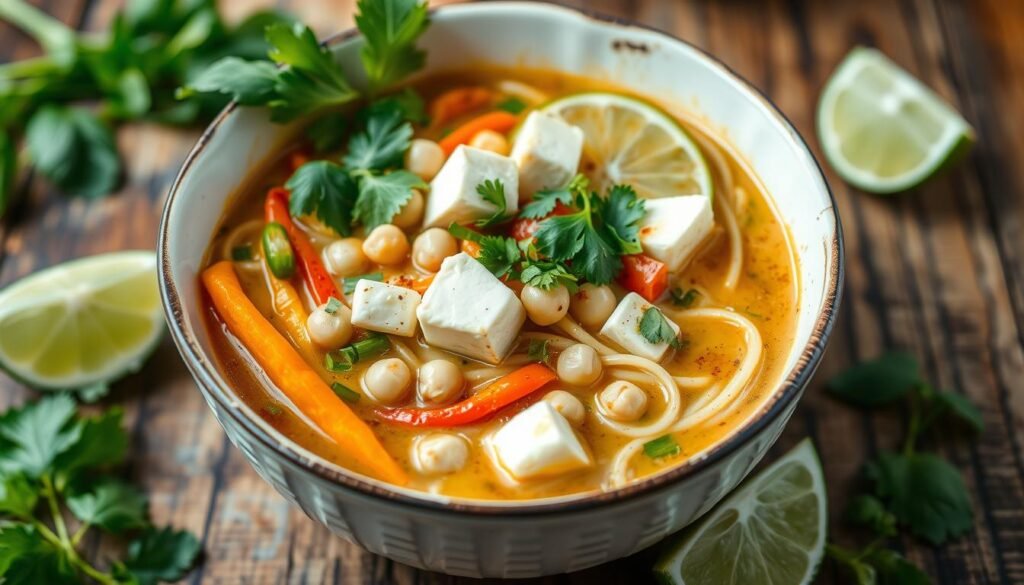
How to Prepare Tofu for Flavor
When preparing tofu to include in your nutritious vegan meal, start by pressing the tofu to remove excess moisture. This step is crucial for achieving a better texture and allowing the tofu to absorb more of the soup’s flavors. Once pressed, cut the tofu into bite-sized cubes and pan-fry them until they are golden brown. This method gives the tofu a delightful crunch on the outside while keeping the inside tender and flavorful.
By following these simple steps, you can transform your Vegan Thai Coconut Noodle Soup into a high-protein vegan soup that meets your dietary needs while being a delicious and nutritious vegan meal. Enjoy the rich flavors and wholesome ingredients in every spoonful!
Spicing Up Your Soup
One of the secret ingredients to a delightful homemade Thai noodle soup is the right spice mix. Thai cuisine often relies on a blend of aromatic spices that not only add heat but also bring out the rich flavors of the other ingredients.
Essential Thai Spices to Use
In my spicy vegan soup, the cornerstone ingredients include red curry paste and turmeric. These components not only lend a vibrant color but also introduce a significant depth of flavor. I often start with one tablespoon of red curry paste and a teaspoon of turmeric. From there, you can adjust the quantities based on your personal heat preference. It’s always a good idea to add spices gradually; you can always add more, but you can’t take it away once it’s in the pot.
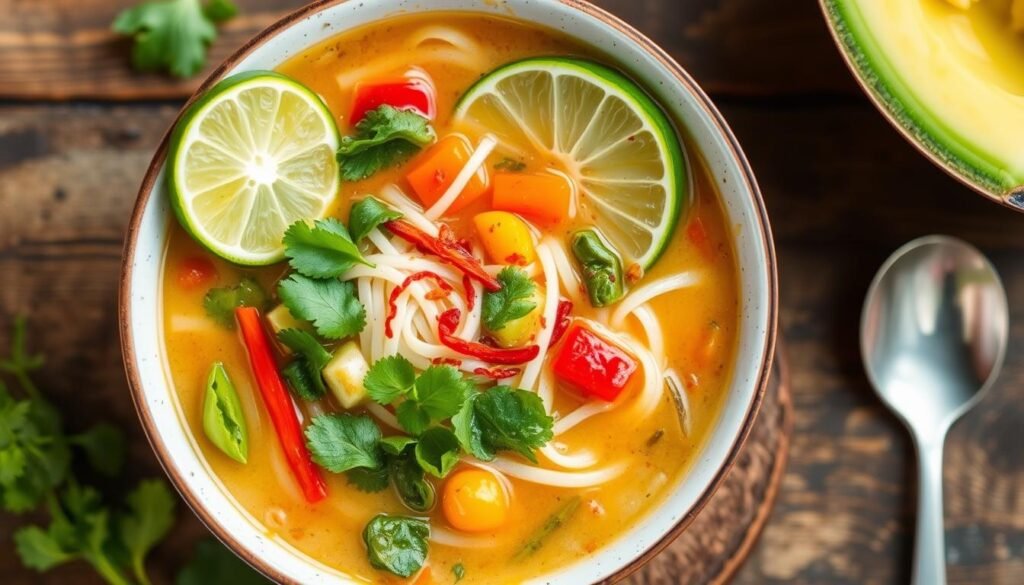
Additionally, incorporating garlic, ginger, and lemongrass can amplify the flavors of your homemade Thai noodle soup. These spices provide a fragrant aroma that highlights the diversity of the dish’s other ingredients. For instance, my go-to recipe also contains chickpeas, which soak up these flavors beautifully, offering a wonderful balance to the spiciness.
Adding Heat – How Much is Enough?
The key to perfecting your spicy vegan soup is understanding how much heat is too much. It’s essential to balance the spiciness to suit your taste, starting with a moderate amount and then scaling up. Generally, I recommend beginning with a teaspoon of red Thai chili flakes or a small piece of fresh red chili. If you find that your soup isn’t spicy enough, you can always add more. Remember, it’s easier to intensify the heat than to reduce it.
Moreover, using fresh ingredients like lime juice can help to balance the overall flavor profile, marrying the heat and the creamy richness from the coconut milk. This combination ensures that each spoonful of your homemade Thai noodle soup is packed with flavor, making every bite a delightful experience.
By taking the time to carefully select and measure your spices, you ensure that your spicy vegan soup will turn out to be a hit. According to reviews, such flavorful Thai soups consistently receive high ratings, like a 4.8 out of 5, which speaks volumes about the satisfaction level among consumers. So, don’t be afraid to experiment and tweak the spice levels to match your taste!
Assembling Your Soup
Assembling a flavorful vegan soup is an art form that balances taste and visual appeal. In this section, I’ll guide you through layering techniques and garnishing tips to create a plant-based coconut noodle soup that’s both delicious and beautiful.
Layering Techniques for Flavor
To achieve a harmonious blend of flavors in your plant-based coconut noodle soup, follow these steps:
- Base Layer: Start by pouring the freshly made broth into your bowl. The broth should be simmered with aromatic herbs and spices to infuse it with rich flavors.
- Noodles and Veggies: Add the cooked noodles and mixed vegetables next. This is where the plant-based protein options like tofu can also be added for an extra protein boost.
- Coconut Milk: Gently pour the coconut milk over the noodles and vegetables. Ensure that the coconut milk has a creamy consistency to make the soup rich and satisfying.
- Final Touch: Top off your soup with a ladle of hot broth to meld the layers together.
Layering the ingredients in stages allows each component to meld properly, creating a cohesive and flavorful vegan soup.
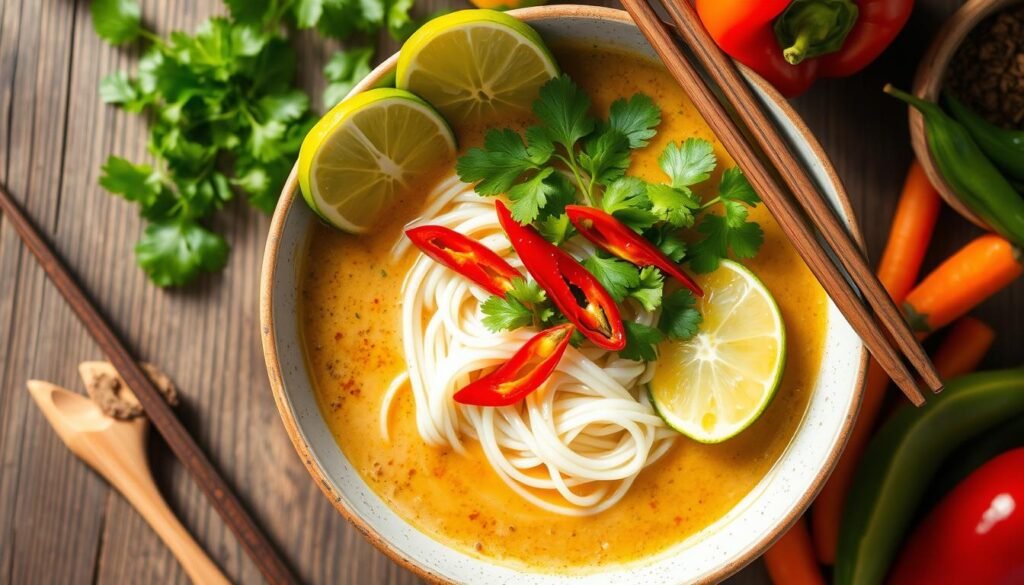
Garnishing Tips for a Beautiful Presentation
Garnishing your plant-based coconut noodle soup not only enhances its visual appeal but also adds fresh flavors:
- Lime Wedges: Place a few lime wedges on the side for a burst of citrusy freshness that diners can squeeze according to their taste.
- Cilantro and Green Onions: Sprinkle chopped cilantro and green onions over the soup. These herbs add color and a fresh, vibrant taste.
- Additional Spices: For those who love a bit of heat, a hint of chili flakes or a dash of sriracha sauce can elevate the soup’s flavor profile.
By carefully assembling and garnishing your soup, you end up with a visually stunning and flavorful vegan soup that will impress anyone. Enjoy the delightful experience of savoring a homemade plant-based coconut noodle soup!
Adjusting As Needed
Creating a customizable vegan meal like Vegan Thai Coconut Noodle Soup means you can easily adjust it to match your taste preferences or dietary requirements. Whether you’re looking to make it spicier or need suggestions for different dietary preferences, this section will guide you.
How to Make it Spicier
If you’re a fan of a little extra heat in your healthy vegan soup, you can easily adjust the spiciness to match your palate. Consider these methods:
- Add more red curry paste. An additional tablespoon can significantly increase the spice level.
- Incorporate fresh Thai chilies. These can be finely chopped and added during the cooking process for an intense kick.
- Use Sriracha or cayenne pepper. These can be added to taste for a customizable spicy experience.
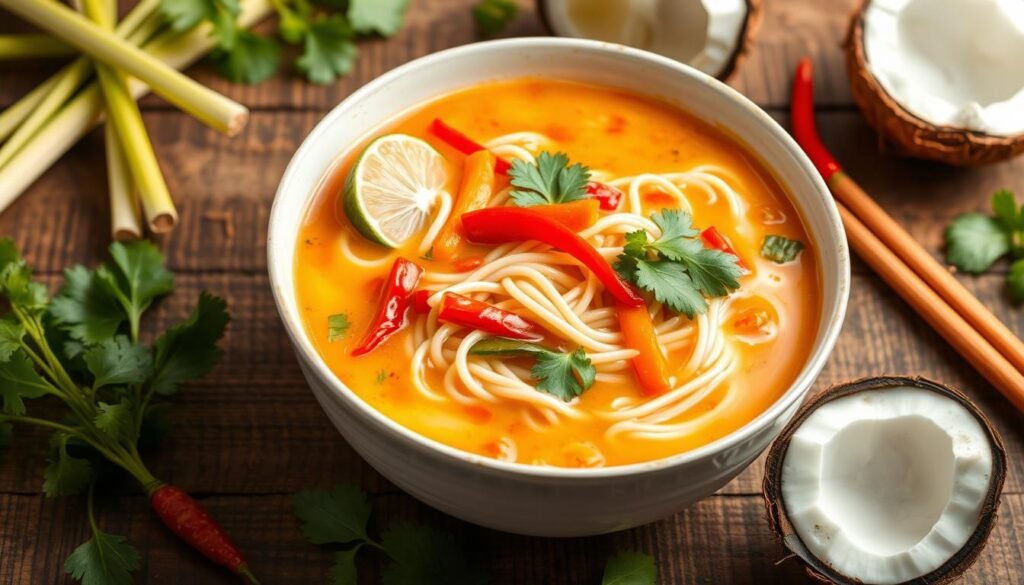
Suggestions for Dietary Preferences
Making sure your Vegan Thai Coconut Noodle Soup caters to various dietary needs can enhance its inclusivity. Here are some simple adjustments:
- Use gluten-free noodles. Swap out regular ramen noodles for gluten-free rice noodles to accommodate gluten-sensitive diets.
- Opt for low-fat coconut milk. Replace full-fat coconut milk with a reduced-fat version to lower the calorie content while maintaining the creamy texture.
- Modify the protein source. Tofu is a great option, but feel free to use other plant-based proteins like chickpeas or tempeh for variety in your customizable vegan meal.
By making these adjustments, you can ensure your Vegan Thai Coconut Noodle Soup remains a delicious and healthy vegan soup, suitable for a wide range of dietary needs.
Storage and Reheating Tips
Proper storage and reheating of your meal prep vegan soup ensure you can enjoy all the flavors and textures, even days later. Here are some essential tips to keep in mind:
Best Practices for Storing Leftovers
When it comes to preserving your easy vegan recipe, the key is to store it properly:
- Ensure the leftovers are stored in a clean, airtight container.
- Keep the container in the fridge. The meal prep vegan soup can keep well for up to two days.
- If planning to store longer, consider freezing the soup. It can be frozen for up to three months for optimal taste and texture.
- Avoid freezing rice noodles and shredded lettuce; only freeze the broth and veggies.
How to Reheat Without Losing Flavor
Reheating your easy vegan recipe correctly is vital to maintain its rich taste:
- Allow the soup to come to room temperature before reheating, if possible.
- Reheat the soup gently on the stove, stirring occasionally.
- To prevent noodles from absorbing too much liquid, add an extra cup of coconut milk when reheating.
- A little extra broth or water can also help retain the original texture and flavor of the meal prep vegan soup.
- Ensure the soup is heated thoroughly before serving, especially if reheating from a frozen state.
Conclusion: Enjoying Your Vegan Thai Coconut Noodle Soup
You’ve made it to the end of our journey to create a delightful vegan Thai Coconut Noodle Soup. This nourishing vegan meal is perfect for a wholesome, satisfying dinner or a hearty lunch. Whether you opt for the stovetop or Instant Pot cooking method, your taste buds are in for a treat as you savor the rich flavors enhanced by authentic Thai spices.
Serving Suggestions with Your Soup
To elevate your vegan dining experience, consider serving your soup with light side dishes such as crispy spring rolls or a fresh Thai mango salad. These sides can complement the depth of flavors in your soup and provide a well-rounded meal. If you’re aiming for a more casual setting, a simple side of steamed jasmine rice could be a great addition. The soup’s flavor profile pairs wonderfully with the subtle fragrance of the rice, enhancing your overall vegan dining experience.
Encouraging Reviews and Feedback
I genuinely hope you enjoy preparing and savoring this vegan Thai Coconut Noodle Soup as much as I do. Your feedback is invaluable in refining this recipe and making it even better for future readers. Please take a moment to leave a review and share your culinary journey with others. How did you find the balance of flavors? Did you experiment with any specific ingredients or cooking methods? Your insights contribute greatly to our collective vegan dining experience.
As you relish each spoonful of this nourishing vegan meal, remember that cooking is an evolving art. Your experiences and feedback can inspire others to embark on their own culinary adventures, making our shared journey both delicious and rewarding. Enjoy!
